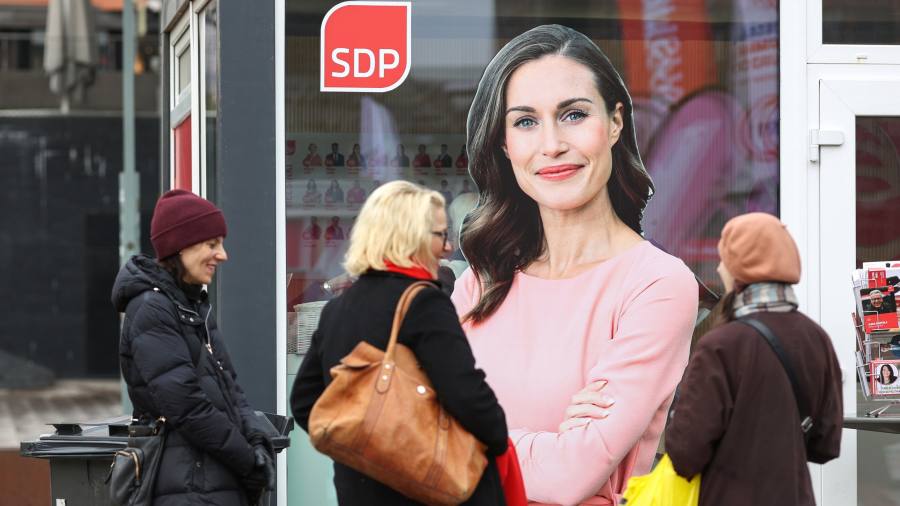
Sanna Marin has deftly handled the Covid-19 pandemic, Russia’s full-scale invasion of Ukraine and Finland’s bid to join Nato. Despite those achievements, the prime minister is struggling to shake off her two rightwing rivals in parliamentary elections on Sunday.
“Sanna Marin has two different images, said Hanna Wass, vice-dean of the University of Helsinki. “Internationally, she’s a superstar. In Finland, she’s more of a polarising figure.”
The sentiment is borne out at the Kamppi mall in central Helsinki, where a giant picture of the Social Democrats leader beams down at shoppers.
“I like her. She speaks plainly, she’s direct and she’s had to deal with a lot in the last few years,” said Katja, pointing to the picture of Marin who, at 37, is one of the youngest prime ministers in the world.
Her colleague Juho disagreed: “I know people love her internationally. But I think she wants to take Finland in the wrong direction. I’m worried about government debt.”
Finland might be on the verge of its biggest foreign policy change in decades with its imminent entry into Nato, but campaigning in the Nordic country has been more focused on typically Finnish economic debates.
That Marin is a more divisive figure at home than abroad owes less to contentious videos of her partying with friends at the prime minister’s residence than with a political debate centred on the merits of austerity versus growth, the health of public finances and government debt.

“There is a very Finnish feature to the elections: people are talking about government debt,” said Tytti Tuppurainen, EU minister and ally of Marin. “Given the years of crisis, the debate has gone back to basics.”
Marin has moved her Social Democrats firmly to the left to offer voters a distinct ideological choice, which is unusual in recent Nordic history where most of the differences between the main parties have been on details, not philosophy.
She wants the next government to invest in growth and blames the rise in debt levels on the pandemic and Russia’s war in Ukraine.
Her rightwing opponents, the mainstream conservative National Coalition party, and the populist anti-immigration Finns want to cut spending to reduce Finland’s debt to gross domestic product level from 73 per cent — below the EU average — to closer to the bloc’s target of 60 per cent.
“Nato membership is a historical change. But because there is such a unified view among parties, it doesn’t help differentiate between parties. We do get differentiation with the economy: it’s an ideological issue,” said Jarmo Lindberg, former chief of defence and a National Coalition candidate.
The last opinion poll put Marin’s Social Democrats in third place, within the statistical margin of error behind the National Coalition and the Finns. All three score between 18.7 and 19.8 per cent, but the Finns were the only party to increase their support from the previous poll.
Marin is used to tight votes. She was elected prime minister in 2019 by just three votes in an internal party race. Within months of her victory, the coronavirus pandemic erupted. Finland emerged as one of the least affected European countries, helped in part by its isolation on the edge of the continent and partly by Marin’s decisive action.
Marin, who was criticised over her lack of political experience after serving just four years as an MP and three years before that as a city councillor before becoming prime minister, then had to deal with Russia’s invasion of Ukraine, another non-Nato neighbour.
She initially ruled out Nato membership, before enthusiastically backing it as public opinion swung heavily in favour of joining the military alliance. “She has more crisis experience than any Finnish politician since the second world war,” said a Finnish security official.
In the midst of the Nato accession, Marin faced intense scrutiny over a raucous party video, which led to accusations that she was being judged by different standards to male politicians.
“I believe that Finnish society and its resilience can withstand me singing and dancing with my friends,” she responded.
Marin, who remains Finland’s most popular politician, stoked controversy in Kyiv this month when she said Helsinki could consider sending Hornet fighter jets to Ukraine once they were taken out of service. That caused a stir among other members of her five-party coalition as well as the president, who leads Finland’s foreign policy.
Marin also provided the campaign’s defining image after she was caught wagging her finger at Riikka Purra, leader of the Finns party. The Social Democrats have ruled out forming a government with the Finns, but the National Coalition party, lead by Petteri Orpo, has not.
If the National Coalition or the Finns win, analysts believe they will probably form a rightwing government together with the help of smaller parties, even if they disagree on issues such as migration and the EU.
But if the Social Democrats come first, they might find it difficult to stitch together a purely leftwing alliance. Experts think they will have to turn to the National Coalition party for a grand coalition.
Antti Lindtman, who was narrowly defeated by Marin in 2019 to become prime minister, said: “Everybody agrees that no matter who wins on Sunday, forming a government will be hard.”